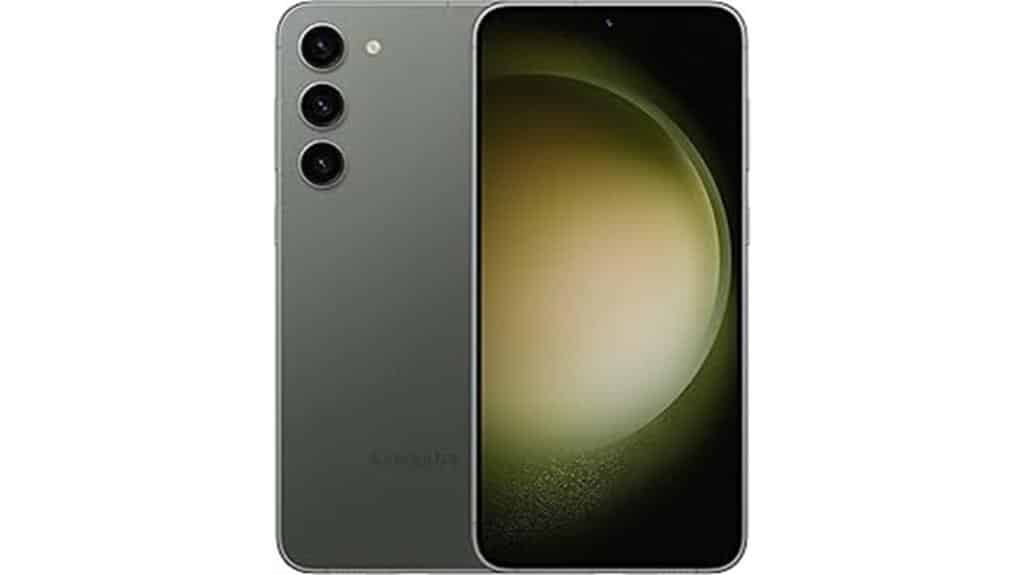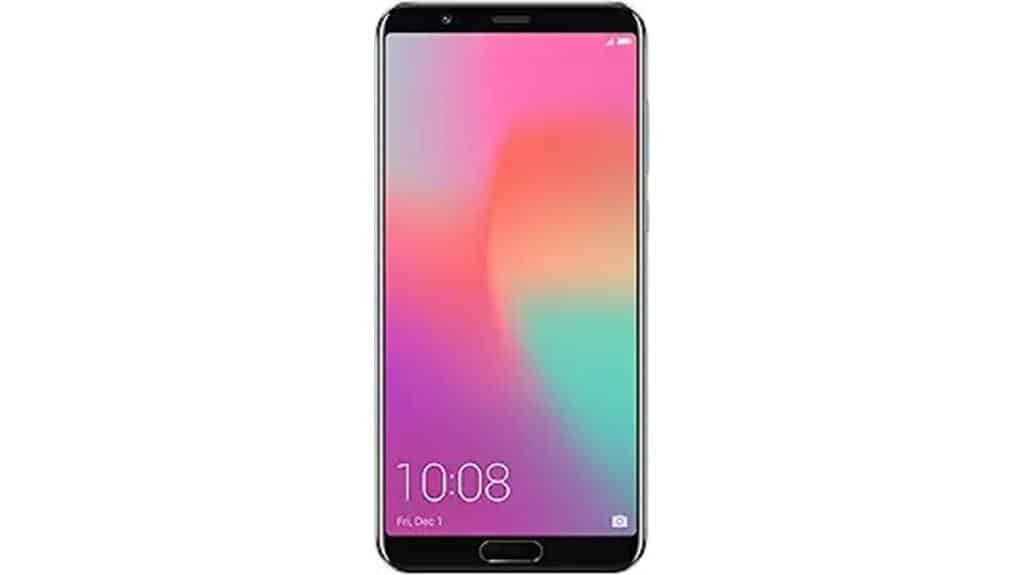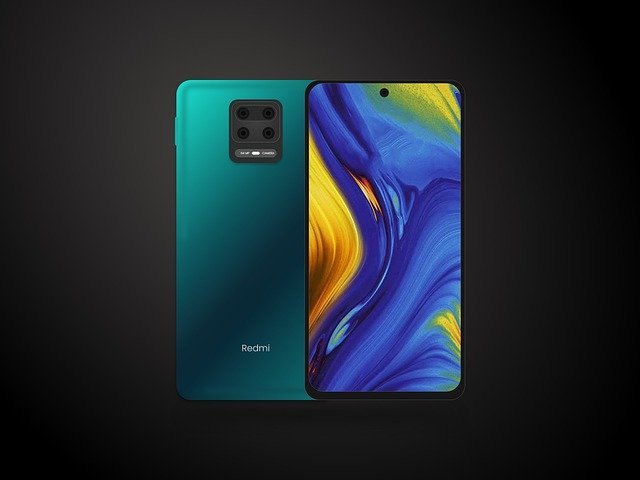When you're looking for a smartphone that excels in low-light photography, the options seem endless, but three models stand out: the Google Pixel 8 Pro, Samsung Galaxy S23+ AI Phone, and Honor View10 GSM SIM-free Smartphone. Each device packs powerful camera hardware and sophisticated software to make night shots vibrant and clear. But what sets these phones apart in real-world usage? Which features should you prioritize, and why do they matter? Before you make your decision, let's explore the unique advantages each of these smartphones offers for capturing stunning low-light photos.
Key Takeaways
- Google Pixel 8 Pro excels in low-light with pro-level cameras and advanced controls for stunning clarity.
- Samsung Galaxy S23+ offers Nightography and advanced zoom capabilities for detailed low-light shots.
- Honor View10's dual-lens AI camera with real-time scene detection delivers excellent low-light performance.
- Superior image stabilization technologies in these phones ensure sharper and clearer images in low-light conditions.
- Robust software processing power and advanced noise reduction algorithms enhance these phones' low-light photography capabilities.
Google Pixel 8 Pro – Unlocked Android Smartphone (512 GB)

The Google Pixel 8 Pro, with its unbridled Android system and 512 GB of storage, is a top contender for anyone seeking superior low-light photography.
You're getting four updated pro-level cameras, including an outstanding telephoto lens that excels in dim conditions. The Pixel's best zoom ever and Pro controls reveal advanced settings, letting you capture full-resolution photos with stunning clarity.
Additionally, the Super Actua display intelligently adjusts refresh rates for smooth and responsive performance, even in challenging lighting.
You'll also appreciate the 5025mAh battery that lasts over 24 hours, ensuring you can shoot day and night.
Plus, with Google AI's Audio Magic Eraser, your videos will maintain impeccable audio quality.
In regard to design, the sleek porcelain finish and comfortable dimensions make it a joy to hold and use.
Best For: Those seeking an exceptional camera experience, long-lasting battery, and sleek design in an unlocked Android smartphone.
Pros:
- Pro-level cameras with excellent low-light and zoom capabilities.
- Intelligent Super Actua display adjusting between 1 and 120Hz for smooth performance.
- Long-lasting battery capable of up to 72 hours with Extreme Battery Saver mode.
Cons:
- Some issues with notification sound and Bluetooth connectivity, although resolved with customer support.
- Might be large for users preferring smaller phones.
- Premium features come at a higher price point.
Samsung Galaxy S23+ AI Phone (Unlocked, 256GB, Green)

Photographers who often find themselves shooting in dimly lit environments will love Samsung Galaxy S23+ AI Phone, especially in its striking green color.
With its 50MP high-resolution camera and Nightography feature, you can capture sharp and epic content even in low light. The 5x optical telephoto and 10x crop zoom capabilities guarantee detailed shots from a distance.
You'll appreciate the 6.6-inch adaptive display and 4700mAh long-lasting battery, perfect for long photography sessions. Running on Android 13.0 and equipped with the fastest mobile processor, it offers seamless multitasking.
The phone's lightweight at 196 grams and supports wireless charging. Despite some Wi-Fi calling issues, its 4.6-star rating from nearly 7,000 users highlights its exceptional performance and camera quality.
Best For: Photographers who require high-quality low-light performance and advanced zoom capabilities in a lightweight and stylish device.
Pros:
- 50MP high-resolution camera with Nightography for excellent low-light photography
- Long-lasting 4700mAh battery and adaptive display for extended use
- Smooth multitasking with the fastest mobile processor and Android 13.0 OS
Cons:
- Some users reported issues with Wi-Fi calling
- Minimal differences in AI capability and chipset compared to the newer S24 Ultra
- Lacks the curved edge display and 10x optical camera found in S23 Ultra
Honor View10 GSM Unlocked Smartphone

Looking for a smartphone that excels in low-light photography? The Honor View10 GSM Unshackled Smartphone might be your answer.
Equipped with a 20MP + 16MP dual-lens AI camera, it leverages AI to enhance your photos in low-light environments. The AI real-time scene and object detection guarantee you capture the best possible shot every time.
This sleek device boasts a 5.99" FullView Display and a powerful AI Processor, providing both beauty and brawn.
Its 3750 mAh battery with smart AI power management keeps you snapping photos longer. Dual SIM 4G, fast charging, and ample 6/128 GB storage make it incredibly versatile.
Despite minor drawbacks like facial recognition issues, the Honor View10 offers exceptional value and performance for photography enthusiasts.
Best For: Photography enthusiasts looking for an affordable smartphone with exceptional low-light performance and advanced AI capabilities.
Pros:
- Amazing battery life with AI power management
- Excellent camera performance with AI real-time scene and object recognition
- Versatile dual SIM 4G capabilities and 128 GB storage
Cons:
- Facial recognition may stop working over time
- Some apps may not function correctly
- Only the OEM fast charger works effectively
Factors to Consider When Choosing Smartphones for Exceptional Low-Light Photography Performance
When you're picking a smartphone for fantastic low-light photos, consider its camera sensor quality and any low-light enhancements.
Pay attention to the aperture and lens specifications, as well as image stabilization technology.
Also, don't forget about the software processing power, which can make or break the final image quality.
Camera Sensor Quality
A high-quality camera sensor can make all the difference in achieving exceptional low-light photography with your smartphone.
When selecting a device, look for sensors with a larger surface area, which capture more light, resulting in clearer images under dim conditions. This translates to better low-light performance and sharper details in your photos.
One key feature to ponder is a backside illumination (BSI) sensor. BSI sensors improve low-light performance by reducing noise and enhancing sensitivity, giving you brighter and more accurate shots.
Another vital factor is the pixel density of the sensor, often measured in micrometers (μm). Higher pixel density allows the sensor to capture finer details, making your low-light photos even more crisp.
The type of sensor matters too. Modern smartphones commonly use CMOS (complementary metal-oxide-semiconductor) sensors, which offer good performance in various lighting conditions.
While CCD (charge-coupled device) sensors are less common, CMOS sensors are generally more efficient and widely adopted.
Low-Light Enhancements
Selecting the right enhancements can truly elevate your low-light photography experience with smartphones.
One key feature to look for is a dedicated low-light mode. This mode amps up the camera's sensitivity to available light, which helps reduce noise and enhances color accuracy in your photos.
Optical image stabilization (OIS) is another must-have. It reduces camera shake and blur caused by hand movement, ensuring your low-light shots come out sharp and clear.
Another enhancement to weigh is advanced multi-frame noise reduction. This technique combines data from multiple frames to effectively reduce noise and improve overall image quality.
It's particularly useful in dim environments where noise can be a significant issue. Additionally, advanced noise reduction algorithms, such as Google's Audio Magic Eraser, can clean up background noises in your audio recordings, making them sound clearer, even in low-light settings.
While we're focusing on low-light shooting here, don't forget about speedy post-processing. Many top-tier smartphones use powerful processors to quickly and efficiently apply these enhancements, ensuring you get the best possible shot without a long wait.
Aperture and Lens
To guarantee exceptional low-light photography performance, prioritize the smartphone's aperture and lens specifications.
A larger aperture, marked by a smaller f-number, allows more light to flood the lens, drastically improving low-light shots. Always look for devices boasting wide apertures like f/1.8 or lower; they'll excel in dim environments.
Don't overlook the lens characteristics. A lens with a wide angle and short focal length can capture more light, but be cautious of potential distortion which can affect image quality.
Balance is key—aim for lenses that offer excellent light capture without compromising the fidelity of your photos.
Consider the number and arrangement of lenses too. Multiple lenses inherently capture more light and provide better optical zoom, enhancing your night-time photography.
Smartphones with dual or triple lens setups often perform superbly in low light.
Pay attention to lens materials as well. Glass lenses outperform plastic ones by allowing more light to enter the camera, leading to sharper and brighter images.
Finally, the lens size matters. Larger lenses permit more light entry, though they can make the device bulky.
Weigh the trade-offs carefully to pick a smartphone that aligns with your low-light photography needs.
Image Stabilization Technology
When you're shooting in low light, how can you guarantee crisp and clear images? The answer lies in effective image stabilization technology.
Optical image stabilization (OIS) physically moves the camera lens to counteract camera shake, which is vital for low-light photography. By reducing shake by up to 4 stops, OIS lets you use slower shutter speeds and lower ISOs, leading to higher-quality images.
However, electronic image stabilization (EIS) operates differently. It uses software to stabilize the image, which can be less effective than OIS, especially at longer focal lengths. This makes OIS generally more dependable for capturing sharper photos in dimly lit environments.
Some smartphones employ a combination of both technologies, known as hybrid image stabilization. This mix of OIS and EIS can offer even better performance, guaranteeing you get the best of both worlds.
Besides photography, image stabilization technology also enhances video recording.
Whether you're capturing footage of a nighttime concert or a cozy evening gathering, having robust image stabilization guarantees smoother and more stable videos, despite the challenging low-light conditions.
Software Processing Power
For exceptional low-light photography performance, a smartphone's software processing power plays a pivotal role.
It lets your phone quickly and accurately process large amounts of image data, turning dim, grainy shots into clear, beautiful photos.
Advanced software processing capabilities, such as multi-frame noise reduction and AI-powered noise reduction, come into play here, substantially enhancing the quality of your low-light images.
A fast processor, like the Google Tensor G3 chip, is essential.
Its high clock speed helps it handle complex tasks efficiently, directly improving your phone's low-light performance.
Fundamentally, the better the processor, the smoother the image processing, and the better your photos look.
To truly tap into the potential of advanced features like Night Mode and Audio Magic Eraser, robust software processing power is a must.
These features use sophisticated algorithms to amplify details and reduce noise, transforming otherwise mediocre shots into impressive ones.
Don't overlook the importance of RAM either.
A minimum of 6GB of RAM guarantees your smartphone can manage demanding image processing tasks without lag or slowdown.
Efficient software processing power can be the difference between ordinary and extraordinary low-light photography.
At a Glance
If you're after top-tier low-light photography, you can't go wrong with the Google Pixel 8 Pro, Samsung Galaxy S23+ AI Phone, or Honor View10. These smartphones offer advanced camera hardware and cutting-edge software to guarantee stunning photos, even in poor lighting. Carefully consider your needs and preferences, and you're sure to choose a device that captures your night scenes beautifully. Enjoy your journey into the world of exceptional low-light photography with confidence.





